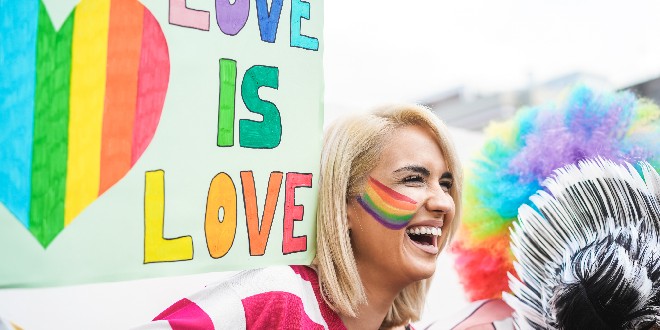Homophobia happens on many levels. The dictionary describes homophobia as a fear or hatred of homosexuality, homosexual people, lesbian, gay and bisexual identity, and refers to the values and behaviours which express this fear and hatred.
Homophobia is any action, attitude, or behavior that discriminates against or unfairly limits same-sex attracted people because of their sexuality (e.g. preventing a same-sex attracted person from bringing their partner to social functions).
Homophobia can take many forms including:
- homophobia
- Function: noun
- Date: 1972
- irrational fear of, aversion to, or discrimination against homosexuality or homosexuals
- homophobic/-‘fO-bik/ adjective
- From Merriam Webster Online
Personal homophobia (internalized, within yourself)
This is the individual’s belief that lesbian, gay and bisexual people are sinful, immoral or inferior to heterosexuals, or incomplete as women or men. These views are always learned and they may be shared by lesbian, gay and bisexual people themselves. In this case the homophobia is internalised.
When a lesbian, gay or bisexual person has internalised the belief that they are sinful, immoral or inferior they may hide their sexuality, try to make it mean less to them, decrease their expectations of life, or engage in behaviours which are harmful to themselves and others.
Interpersonal homophobia (between two or more people)
This is the dislike, fear or hatred of people who are lesbian, gay or bisexual. This dislike, fear or hatred may be expressed through name-calling, verbal or physical harassment or acts of discrimination.
Most common examples of interpersonal homophobia are shunning, being excluded from a group or name calling and even physical abuse.
Institutional homophobia
This refers to the many ways in which government, business, churches and other organisations discriminate against people on the basis of their sexual orientation. These organisations set policies, allocate resources and maintain unwritten standards for the behaviour of their members or constituents which discriminate.
Cultural homophobia
This refers to social standards and norms which dictate that being heterosexual is better than being lesbian, gay or bisexual. These standards and norms are reinforced each day in television shows, movies and print advertisements where virtually every character is heterosexual and every sexual and social relationship involves a female and a male, or in the assumption made by most adults that all children will eventually be attracted to and marry a person of the opposite sex. Often heterosexuals do not realise that these standards exist, while lesbian, gay and bisexual people are acutely aware of them. This results in lesbians, gays and bisexuals feeling like outsiders in society.
In day-to-day life, the following are examples of homophobic behaviours and attitudes many of us are guilty of:
- thinking you can “spot one”
- using words like “poof”, “dyke”, “fag”, “gay”, “lezzo” as an insult
- thinking that a same-sex attracted friend is trying to “pick you up”, if they are friendly towards you
- not being supportive of a same-sex attracted friend when they break up with their partner
- making unnecessary or rude comments about, or feeling repulsed by public displays of affection between same-sex partners
- feeling that lesbian, gay , bisexual, transgender and intersex people are too outspoken about civil rights
- assuming that everyone you meet is heterosexual
- assuming that a lesbian is just a woman who couldn’t find a man or that a lesbian is a woman who secretly wants to be a man
- assuming that a gay man is just a man who couldn’t find a woman or that a gay man is a man who secretly wants to be a woman
- assuming bisexual people are confused or want to “play the field”
- not confronting a homophobic remark for fear of being labeled as gay
Is it homophobia or heterosexism?
- heterosexism
- Function: noun
- Date: 1972
- discrimination or prejudice by heterosexuals against homosexuals
- heterosexist \-‘sek-sist\ adjective
- From Merriam Webster Online
Heterosexism
Is the assumption most people make that everyone is heterosexual and those who aren’t are abnormal or strange.
Is the belief that heterosexuality and heterosexual people are superior to and more valuable than homosexuality and homosexual people. It is comparable to sexism and racism.
Is the belief in the inherent superiority of one type of love and relationship and thereby their right to dominance.
Is the set of assumptions that excludes openly homosexual people from social, religious, and political power. It is a system of coercion that demands heterosexuality in return for first class citizenship.
When describing incidents of discrimination or harassment against lesbian, gay, bisexual, transgender and intersex people, it may be more precise to use the terms anti-LGBT bias or hate acts. And when discussing the belief, held by so many, that homosexuality is “wrong” or “less than,” it may be more accurate to use heterosexism.
How homophobia hurts us all
Name-calling is more than just a joke. Words that don’t mean much to some people can deeply hurt and offend others. It may not even hurt someone who is same sex attracted, but someone who is a close friend or maybe even a family member.
If you have experienced any form of homophobia you should report it. You don’t have to hide. Speak to someone.
Nine things you can do to stop homophobia now:
In schools
- Challenge the use of the word “gay” to mean second rate or bad
- Start a school anti-homophobia group and publish information about homophobia in your school newsletter
In families, groups and the community
- Challenge derogatory or demeaning statements, pointing out the harm that it causes (e.g. comments like “That’s so gay” or anti-gay jokes)
- Highlight examples of families, organisations and communities with LGBTI members which have successfully accepted these members
- Don’t expect change to happen overnight – be patient with and show respect to those with different views
In the workplace
- Make sure your workplace has an anti-harassment policy that covers lesbian, gay, bisexual transgender and intersex issues and is enforceable
- Challenge those who make slurs, jokes or other comments that demean or attack people on the basis of their sexual orientation or gender identity, or their perceived sexual orientation or gender identity
- Be prepared with what you might say in response to discriminatory comments. For example, ‘sexual orientation isn’t important. What is important is that workers do their job properly.’
 Lesbian, Gay, Bisexual, Transgender & Intersex News Lesbian News, Gay News, Bisexual News, Transgender News, Intersex News, LGBTI News
Lesbian, Gay, Bisexual, Transgender & Intersex News Lesbian News, Gay News, Bisexual News, Transgender News, Intersex News, LGBTI News




